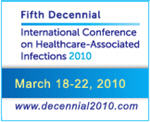Healthcare-Associated Infections (HAIs)
Healthcare-associated infections are infections that patients acquire during the course of receiving treatment for other conditions within a healthcare setting. Healthcare-associated infections are one of the top ten leading causes of death in the United States. As the nation’s health protection agency, CDC is committed to helping all Americans receive the best and safest care when they are treated at a hospital or other healthcare facility.
Infection Control Topics
- Infection Control Home
- Healthcare-Associated Infections
- Protecting Patients
- Protecting Healthcare Workers
- Infection Control Guidelines
- Infection Control A-Z
- About DHQP
Infection Control Resources
- HAIs: Recovery Act - information on obtaining funding through the Epidemiology and Laboratory Capacity (ELC) and Emerging Infections Program (EIP).
- HICPAC - Healthcare Infection Control Practices Advisory Committee
- Bioterrorism - Emergency Preparedness & Response
- Rapid Notification System
Sign-up now for email updates of recalls and important web postings
Topics
-
In response to the increasing concerns about the public health impact of healthcare-associated infections (HAIs), the US Department of Health and Human Services (HHS) has developed an Action Plan to Prevent Healthcare-Associated Infections (HHS Action Plan).
-
 Healthcare-Associated Infections: Recovery Act
Healthcare-Associated Infections: Recovery ActInformation on obtaining funding through the Epidemiology and Laboratory Capacity (ELC) and Emerging Infections Program (EIP).
-
 Estimates of Healthcare-Associated Infections
Estimates of Healthcare-Associated InfectionsInformation relating to infections acquired within a healthcare setting.
-
 List of Infectious Diseases in Healthcare Settings
List of Infectious Diseases in Healthcare SettingsDiseases that may be transmitted within healthcare facilities and how to prevent their transmission to patients and healthcare workers.
-
Bacteria that have developed resistance to certain antibiotics and how to prevent their transmission and conduct laboratory testing.
-
HIV, Hepatitis C and other pathogens that may be transmitted in healthcare settings via blood or bodily fluids and how to prevent transmission.
-
 SHEA/IDSA HAI Prevention Compendium
SHEA/IDSA HAI Prevention CompendiumAs CDC continues to produce official guidelines in collaboration with professional societies and academic partners, implementation tools such as this compendium will serve as a means to ensure that the best practices for infection prevention are successfully brought to the bedside.
* Links to non-Federal organizations found at this site are provided solely as a service to our users. These links do not constitute an endorsement of these organizations or their programs by CDC or the Federal Government, and none should be inferred. CDC is not responsible for the content of the individual organization Web pages found at these links.
Content source:
Division of Healthcare Quality Promotion (DHQP)
National Center for Preparedness, Detection, and Control of Infectious Diseases

 State HAI Plan Template
State HAI Plan Template

